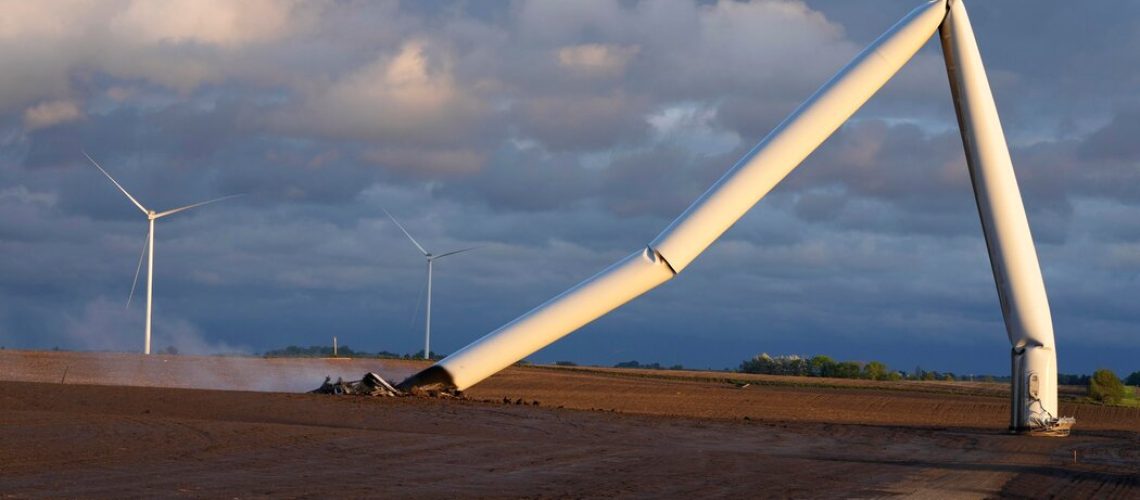The footage from southwest Iowa is shocking: In the trail of a tornado, a wind turbine is bent in half like a cheap straw, its hub engulfed in flames and thick black smoke, its blades on the ground.
“You’re seeing multiple of these big wind turbine towers that have been destroyed,” Zane Satre, a meteorologist for KCCI 8 News in Des Moines, told viewers. “These are big tall ones — I think they’re what, like 250 feet tall? Well that tornado took them out.”
But it’s rare for tornadoes or other types of severe weather to destroy a wind turbine, said Fraser McLachlan, chief executive of GCube, a company that insures renewable energy projects like wind farms and solar arrays.
Turbines are now built to withstand events like tornadoes, hurricanes and typhoons because of advances in technology since the early designs of the 1990s. They have built-in mechanisms to lock and feather the blades, changing their angles, when winds reach 55 miles per hour. That reduces the surface area of the blades pointed toward the wind.
“You will lose a blade here or a blade there,” during windstorms, Mr. McLachlan said. But a complete knockout is unusual, he said.
The damage in Iowa to three turbines was part of a spell of bad weather that struck the state on Tuesday, leaving multiple people dead and at least a dozen injured. The storms followed other deadly weather in the region, including in Missouri, Illinois and Kentucky. It’s part of what scientists say is a trend: As average temperatures rise, severe storms are becoming more frequent and powerful, for reasons that aren’t always clear.
The Midwest is getting hit with more frequent disasters at the same time that wind and solar power generation is expanding.
In 2022, about two-thirds of Iowa’s total net electricity generation came from renewable resources and almost all of that was wind, according to the U.S. Energy Information Administration. The state was second only to Texas in terms of the amount of wind power it produced. Wind was responsible for 62 percent of Iowa’s net generation, the highest share of any state.
When it comes to extreme weather and renewable energy, the larger problem is the vulnerability of solar panels to hailstorms, Mr. McLachlan said.
To reduce costs, panels have become larger over time, and the glass has become thinner, making it more likely to crack when hail strikes. That’s happening as more solar panels are being installed in the hail-prone Midwest — and as the frequency and severity of hail increase.
The standard way to protect solar panels from hailstones is to change their angle, Mr. McLachlan said, tipping them so that their surface is less exposed to direct hits. But that creates a new problem: those panels start to act like sails, catching the winds that often accompany hail, increasing the risk of blowing away.
Hail made up 54 percent of incurred costs from insurance claims for the solar sector over the past five years, according to a report from GCube last year, despite accounting for just 1.4 percent of claims. Growing losses from hail have made it harder to get insurance for solar projects, Mr. McLachlan said.
Still, renewable power isn’t the only part of the electricity generation industry to face threats from extreme weather, said Elise Caplan, vice president of regulatory affairs for the American Council on Renewable Energy. She said that natural gas facilities can be shut down during extreme cold spells, and droughts can put limits on nuclear plants that need cooling water.
“There’s no perfect generation resource,” Ms. Caplan said. “There’s so many different types of extreme scenarios that impact generation in different ways.”
The focus, Ms. Caplan said, should be on a mix of power generation types, as well as expanded transmission lines that can move that power where it’s most needed.



